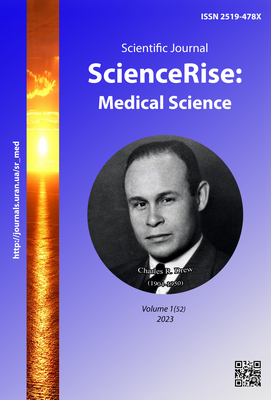Determining the risk of miscarriage in genetic forms of thrombophilia
DOI:
https://doi.org/10.15587/2519-4798.2023.275612Keywords:
habitual miscarriage, genetic thrombophilia, pregnancy complications, prognosis, genes polymorphismsAbstract
The aim: to study the distribution and influence of coagulation factor gene polymorphisms and endothelial dysfunction on the development of recurrent pregnancy loss.
Materials and methods: a prospective case-control study included 109 pregnant women in the 1st trimester with habitual miscarriage and 34 conditionally healthy pregnant women with an uncomplicated obstetrical anamnesis without risk factors for miscarriage. Genetic polymorphisms of coagulation and fibrinolysis factors (1691 G→A FVL, 20210 G→A prothrombin, 675 5G/4G PAI-1, 455 G→A fibrinogen β), as well as endothelial dysfunctions (192 Q→R PON-1, 677 C → T MTHFR) were investigated using allele-specific polymerase chain reaction.
Results: Pathological polymorphisms of the genes of the hemostasis system and endothelial dysfunction play a significant role in the development of miscarriage, namely such pathological genotypes as 1691 GA of factor V Leiden - increases the risk by 5.3 times (95 % CI 1.5-18.5), 20210 GA of prothrombin - by 26.47 times (1.6-445.7), 675 4G/4G PAI-1 - by 7, 5 times (1.7-33.79), -455AA fibrinogen β - 9.7 times (1.3-74.16), 677 CT MTHFR - 2.6 times (1.0-6.2), 677 TT MTHFR - 21.7 times (1.3-368.6). Multigenic forms of thrombophilia predominate in the majority of patients with miscarriage and account for 76.1 % (p<0.001, OR=12.31, 95 % CI 4.8-31.55). It was determined that the simultaneous presence of two pathological polymorphisms increases the risk of miscarriage by 3.88 times (OR 3.38; 95 % CI 1.26-9.97), and three ones - more than 2.5 times (OR 2.66; 95 % CI 1.02-7.19).
Conclusions: the course of pregnancy against the background of pathological polymorphisms of the genes of the hemostasis system and endothelial dysfunction significantly increases the risk of habitual miscarriage, which should be considered when planning a pregnancy in women with habitual miscarriage
References
- Toth, B., Würfel, W., Bohlmann, M., Zschocke, J., Rudnik-Schöneborn, S., Nawroth, F. et al. (2018). Recurrent Miscarriage: Diagnostic and Therapeutic Procedures. Guideline of the DGGG, OEGGG and SGGG (S2k-Level, AWMF Registry Number 015/050). Geburtshilfe Und Frauenheilkunde, 78 (4), 364–381. doi: https://doi.org/10.1055/a-0586-4568
- Bender Atik, R., Christiansen, O. B., Elson, J., Kolte, A. M., Lewis, S., Middeldorp, S. et al. (2018). ESHRE guideline: recurrent pregnancy loss. Human Reproduction Open, 2018 (2). doi: https://doi.org/10.1093/hropen/hoy004
- Homer, H. A. (2018). Modern management of recurrent miscarriage. Australian and New Zealand Journal of Obstetrics and Gynaecology, 59 (1), 36–44. doi: https://doi.org/10.1111/ajo.12920
- Magnus, M. C., Wilcox, A. J., Morken, N.-H., Weinberg, C. R., Håberg, S. E. (2019). Role of maternal age and pregnancy history in risk of miscarriage: prospective register based study. BMJ, 364, l869. doi: https://doi.org/10.1136/bmj.l869
- Li, Y. H., Marren, A. (2018). Recurrent pregnancy loss: A summary of international evidence-based guidelines and practice. Australian Journal of General Practice, 47 (7), 432–436. doi: https://doi.org/10.31128/ajgp-01-18-4459
- van Dijk, M. M., Kolte, A. M., Limpens, J., Kirk, E., Quenby, S., van Wely, M., Goddijn, M. (2020). Recurrent pregnancy loss: diagnostic workup after two or three pregnancy losses? A systematic review of the literature and meta-analysis. Human Reproduction Update, 26 (3), 356–367. doi: https://doi.org/10.1093/humupd/dmz048
- Musters, A. M., Koot, Y. E., van den Boogaard, N. M., Kaaijk, E., Macklon, N. S., van der Veen, F. et al. (2013). Supportive care for women with recurrent miscarriage: a survey to quantify women's preferences. Human reproduction, 28 (2), 398–405. doi: https://doi.org/10.1093/humrep/des374
- Sergi, C., Al Jishi, T., Walker, M. (2014). Factor V Leiden mutation in women with early recurrent pregnancy loss: a meta-analysis and systematic review of the causal association. Archives of Gynecology and Obstetrics, 291 (3), 671–679. doi: https://doi.org/10.1007/s00404-014-3443-x
- Liu, X., Chen, Y., Ye, C., Xing, D., Wu, R., Li, F., Chen, L., Wang, T. (2021). Hereditary thrombophilia and recurrent pregnancy loss: a systematic review and meta-analysis. Human Reproduction, 36 (5), 1213–1229. doi: https://doi.org/10.1093/humrep/deab010
- Croles, F. N., Nasserinejad, K., Duvekot, J. J., Kruip, M. J., Meijer, K., Leebeek, F. W. (2017). Pregnancy, thrombophilia, and the risk of a first venous thrombosis: systematic review and bayesian meta-analysis. BMJ, 359, j4452. doi: https://doi.org/10.1136/bmj.j4452
- Jusic, A., Balic, D., Avdic, A., Podanin, M., Balic, A. (2018). The association of factor V G1961A (factor V Leiden), prothrombin G20210A, MTHFR C677T and PAI-1 4G/5G polymorphisms with recurrent pregnancy loss in Bosnian women. Medicinski glasnik, 15 (2), 158–163. doi: https://doi.org/10.17392/948-18
- Favaloro, E. J. (2019). Genetic Testing for Thrombophilia-Related Genes: Observations of Testing Patterns for Factor V Leiden (G1691A) and Prothrombin Gene “Mutation” (G20210A). Seminars in Thrombosis and Hemostasis, 45 (7), 730–742. doi: https://doi.org/10.1055/s-0039-1694772
- Arachchillage, D. J., Mackillop, L., Chandratheva, A., Motawani, J., MacCallum, P., Laffan, M. (2022). Thrombophilia testing: A British Society for Haematology guideline. British Journal of Haematology, 198 (3), 443–458. doi: https://doi.org/10.1111/bjh.18239
Downloads
Published
How to Cite
Issue
Section
License
Copyright (c) 2023 Tetiana Loskutova, Albina Petulko

This work is licensed under a Creative Commons Attribution 4.0 International License.
Our journal abides by the Creative Commons CC BY copyright rights and permissions for open access journals.
Authors, who are published in this journal, agree to the following conditions:
1. The authors reserve the right to authorship of the work and pass the first publication right of this work to the journal under the terms of a Creative Commons CC BY, which allows others to freely distribute the published research with the obligatory reference to the authors of the original work and the first publication of the work in this journal.
2. The authors have the right to conclude separate supplement agreements that relate to non-exclusive work distribution in the form in which it has been published by the journal (for example, to upload the work to the online storage of the journal or publish it as part of a monograph), provided that the reference to the first publication of the work in this journal is included.









